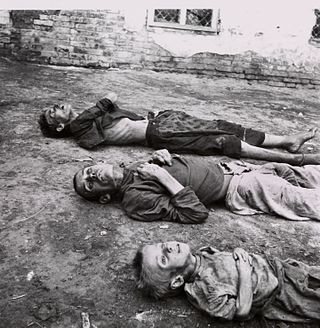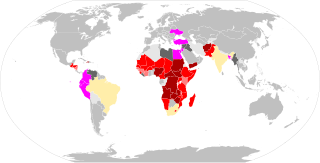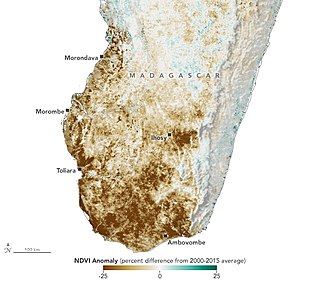
The Great Famine, also known as the Great Hunger, the Famine and the Irish Potato Famine, was a period of starvation and disease in Ireland lasting from 1845 to 1852 that constituted a historical social crisis and subsequently had a major impact on Irish society and history as a whole. The most severely affected areas were in the western and southern parts of Ireland—where the Irish language was dominant—and hence the period was contemporaneously known in Irish as an Drochshaol, which literally translates to "the bad life" and loosely translates to "the hard times". The worst year of the famine was 1847, which became known as "Black '47". During the Great Hunger, roughly 1 million people died and more than 1 million more fled the country, causing the country's population to fall by 20–25% between 1841 and 1871. Between 1845 and 1855, at least 2.1 million people left Ireland, primarily on packet ships but also on steamboats and barques—one of the greatest exoduses from a single island in history.

A famine is a widespread scarcity of food caused by several possible factors, including, but not limited to war, natural disasters, crop failure, widespread poverty, an economic catastrophe or government policies. This phenomenon is usually accompanied or followed by regional malnutrition, starvation, epidemic, and increased mortality. Every inhabited continent in the world has experienced a period of famine throughout history. During the 19th and 20th century, Southeast and South Asia, as well as Eastern and Central Europe, suffered the greatest number of fatalities. Deaths caused by famine declined sharply beginning in the 1970s, with numbers falling further since 2000. Since 2010, Africa has been the most affected continent in the world by famine.

The Population Bomb is a 1968 book co-authored by former Stanford University professor Paul R. Ehrlich and former Stanford senior researcher in conservation biology Anne H. Ehrlich. From the opening page, it predicted worldwide famines due to overpopulation, as well as other major societal upheavals, and advocated immediate action to limit population growth. Fears of a "population explosion" existed in the mid-20th century baby boom years, but the book and its authors brought the idea to an even wider audience.

Norman Ernest Borlaug was an American agronomist who led initiatives worldwide that contributed to the extensive increases in agricultural production termed the Green Revolution. Borlaug was awarded multiple honors for his work, including the Nobel Peace Prize, the Presidential Medal of Freedom and the Congressional Gold Medal, one of only seven people to have received all three awards.

Paul Ralph Ehrlich is an American biologist known for his predictions and warnings about the consequences of population growth, including famine and resource depletion. Ehrlich is the Bing Professor Emeritus of Population Studies of the Department of Biology of Stanford University.
Famine relief is an organized effort to reduce starvation in a region in which there is famine. A famine is a phenomenon in which a large proportion of the population of a region or country are so undernourished that death by starvation becomes increasingly common. In spite of the much greater technological and economic resources of the modern world, famine still strikes many parts of the world, mostly in the developing nations.

Malthusianism is the theory that population growth is potentially exponential, according to the Malthusian growth model, while the growth of the food supply or other resources is linear, which eventually reduces living standards to the point of triggering a population decline. This event, called a Malthusian catastrophe occurs when population growth outpaces agricultural production, causing famine or war. Initially, right before the crisis, poverty and inequality will increase as the price of assets and scarce commodities goes up due to fierce competition for these dwindling resources. This increased level of poverty eventually causes depopulation by decreasing birth rates. As time goes on, and asset prices keep increasing, social unrest occurs, which ultimately causes a major war, revolution, or a famine. Societal collapse is an extreme but possible outcome from this process. Such a catastrophe inevitably has the effect of forcing the population to "correct" back to a lower, more easily sustainable level. Malthusianism has been linked to a variety of political and social movements, but almost always refers to advocates of population control.
Human overpopulation describes a concern that human populations may become too large to be sustained by their environment or resources in the long term. The topic is usually discussed in the context of world population, though it may concern individual nations, regions, and cities.
The North Korean famine, also known as the Arduous March, was a period of mass starvation together with a general economic crisis from 1994 to 1998 in North Korea. During this time there was an increase in defection from North Korea which peaked towards the end of the famine period.

The Green Revolution was a period that began in the 1960's during which agriculture in India was converted into a modern industrial system by the adoption of technology, such as the use of high yielding variety (HYV) seeds, mechanised farm tools, irrigation facilities, pesticides, and fertilizers. Mainly led by agricultural scientist M. S. Swaminathan in India, this period was part of the larger Green Revolution endeavor initiated by Norman Borlaug, which leveraged agricultural research and technology to increase agricultural productivity in the developing world. Varieties or strains of crops can be selected by breeding for various useful characteristics such as disease resistance, response to fertilizers, product quality and high yields.

In international politics, food power is the use of agriculture as a means of political control whereby one nation or group of nations offers or withholds commodities from another nation or group of nations in order to manipulate behavior. Its potential use as a weapon was recognised after OPEC’s earlier use of oil as a political weapon. Food has a major influence on political actions of a nation. In response to acts of food power, a nation usually acts in the interest of its citizens to provide food.
The Soviet famine of 1946–1947 was a major famine in the Soviet Union that lasted from mid-1946 to the winter of 1947 to 1948.

Occurring between July 2011 and mid-2012, a severe drought affected the entire East African region. Said to be "the worst in 60 years", the drought caused a severe food crisis across Somalia, Djibouti, Ethiopia and Kenya that threatened the livelihood of 9.5 million people. Many refugees from southern Somalia fled to neighboring Kenya and Ethiopia, where crowded, unsanitary conditions together with severe malnutrition led to a large number of deaths. Other countries in East Africa, including Sudan, South Sudan and parts of Uganda, were also affected by a food crisis.
The Great Famine was a period of mass starvation during the Axis occupation of Greece (1941–1944), during World War II. The local population suffered greatly during this period, while the Axis Powers initiated a policy of large-scale plunder. Requisitions, together with a blockade by the Allies, the ruined state of the country's infrastructure after the German invasion of Greece, and the emergence of a powerful and well-connected black market, resulted in the Great Famine, with the mortality rate reaching a peak during the winter of 1941–42.

The Great Famine of Mount Lebanon (1915–1918) was a period of mass starvation on Mount Lebanon during World War I that resulted in the deaths of 200,000 people, most of whom were Maronite Christians.

The Persian famine of 1917–1919 was a period of widespread mass starvation and disease in Iran under the rule of the Qajar dynasty during World War I. The famine took place in the territory of Iran, which, despite declaring neutrality, was occupied by the forces of the British, Russian and Ottoman empires whose occupation contributed to the famine. So far, few historians have researched the famine, making it an understudied subject of modern history.

In the early months of 2017, parts of South Sudan experienced a famine following several years of instability in the country's food supply caused by war and drought. The famine, largely focused in the northern part of the country, affected an estimated five million people. In May 2017, the famine was officially declared to have weakened to a state of severe food insecurity.
The Iranian famine of 1942–1943 refers to a period of starvation that took place in Iran, which was under the rule of the Pahlavi dynasty. Iran at the time was occupied by the United Kingdom and Soviet Union despite being a neutral country in the Second World War.

During the COVID-19 pandemic, food insecurity intensified in many places. In the second quarter of 2020, there were multiple warnings of famine later in the year. In an early report, the Nongovernmental Organization (NGO) Oxfam-International talks about "economic devastation" while the lead-author of the UNU-WIDER report compared COVID-19 to a "poverty tsunami". Others talk about "complete destitution", "unprecedented crisis", "natural disaster", "threat of catastrophic global famine". The decision of the WHO on 11 March 2020, to qualify COVID as a pandemic, that is "an epidemic occurring worldwide, or over a very wide area, crossing international boundaries and usually affecting a large number of people" also contributed to building this global-scale disaster narrative.

In mid-2021, a severe drought in southern Madagascar caused hundreds of thousands of people, with some estimating more than 1 million people including nearly 460,000 children, to suffer from food insecurity or famine. Some organizations have attributed the situation to the impact of climate change and the handling of the COVID-19 pandemic in the country.














